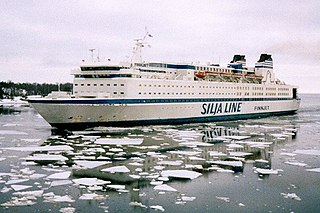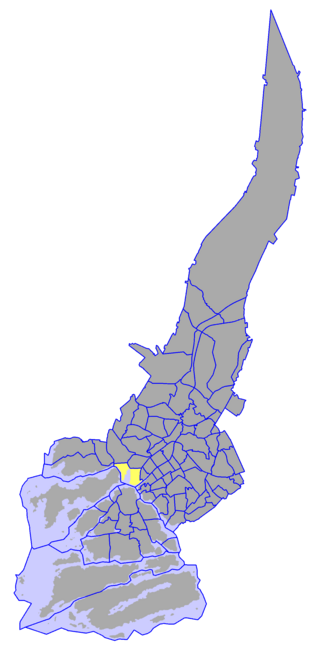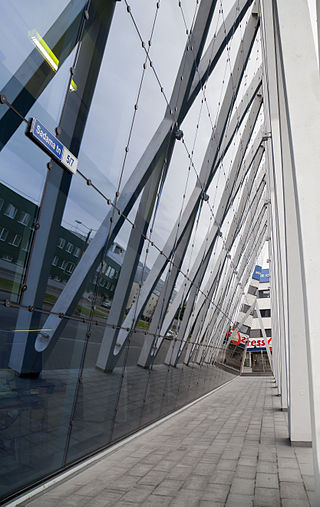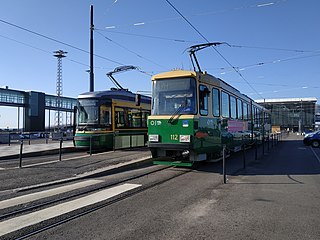Silja Line is a Swedish-Finnish cruiseferry brand operated by the Estonian ferry company AS Tallink Grupp, for car, cargo and passenger traffic between Finland and Sweden.

Viking Line Abp is a Finnish shipping company that operates a fleet of ferries and cruiseferries between Finland, the Åland Islands, Sweden and Estonia. Viking Line shares are quoted on the Helsinki Stock Exchange. Viking Line is operated from Åland.

Långnäs is a port in Lumparland on the eastern mainland of Åland, about 30 km over the road away from Åland's capital Mariehamn. Road ferries to Kumlinge (Snäckö) and Galtby via Föglö (Överö) and Kökar start here. Långnäs is an alternative to Åland's main passenger harbour, the Western Harbour in Mariehamn, for ferries between Finland and Sweden.

MS Estonia was a cruiseferry built in 1980 for the Finnish company Rederi Ab Sally by Meyer Werft, in Papenburg West Germany. She was employed on ferry routes between Finland and Sweden by various companies until 1993, when she was sold to Nordström & Thulin for use on Estline's Tallinn–Stockholm route. The ship's sinking on 28 September 1994, in the Baltic Sea between Sweden, Finland and Estonia, was one of the worst peacetime maritime disasters of the 20th century, claiming 852 lives.

MS Gabriella is a cruiseferry sailing on a route connecting Helsinki, Finland and Stockholm, Sweden for Viking Line. She was built in 1992 in Brodosplit, Croatia as Frans Suell for service with Euroway. Between 1994 and 1997 she sailed as Silja Scandinavia for Silja Line. Gabriella has sister ships Amorella in Viking Line fleet, Isabelle operated by Tallink, and a third one, Crown Seaways, operated by DFDS Seaways.

MS Silja Europa is a cruiseferry constructed at Meyer Werft Germany for the Swedish ferry operator Rederi AB Slite, a part of Viking Line. At 59,914 gross tonnage (GT), she is the largest ship commissioned for and to ever operate for Tallink Silja, and is the tenth-largest cruiseferry in the world.

GTS Finnjet was a cruiseferry, built in 1977 by Wärtsilä Helsinki Shipyard, Finland for Finnlines traffic between Finland and Germany. At the time of her delivery, Finnjet was the fastest, longest and largest car ferry in the world, and the only one powered by gas turbines. At the point of her scrapping in 2008, she remained the fastest conventional ferry in the world, with a recorded top speed of 33.5 knots.

Mega Andrea is a cruiseferry owned and operated by Corsica Ferries Sardinia Ferries. She was formerly owned and operated by the Estonia-based Tallink as the MS Silja Festival, and used on their route connecting Riga, Latvia to Stockholm, Sweden. She was built in 1986 by Wärtsilä Helsinki Shipyard, Finland, for Effoa as MS Wellamo for use on Silja Line traffic. She was rebuilt in 1992 at Lloyds Werft, Bremerhaven, Germany as Silja Festival. In 2008 the ship was transferred from the Silja Line fleet to that of Tallink, but she retained her Silja-prefixed name. After being replaced by MS Isabelle on the Stockholm-Riga route in May 2013 she was chartered as an accommodation ship to Kitimat, British Columbia. She was then sold in early 2015 to Corsica Ferries.

Celestyal Crystal, previously Louis Cristal, is a cruise ship operated by the Cyprus-based Celestyal Cruises and previously Louis Cruise Lines, both in the Louis Group. The ship was originally built as the cruiseferry MS Viking Saga in 1980 at Wärtsilä Perno Shipyard and Turku Shipyard, Turku, Finland for Rederi Ab Sally. In 1986 she was renamed MS Sally Albatross, and rebuilt into a cruise ship the following year. The ship was destroyed by a fire in 1990, and completely rebuilt at Finnyards, Rauma, Finland. She was re-delivered in 1992, still named Sally Albatross. After partially sinking 1994 she was rebuilt at Industrie Navali Meccaniche Affini, La Spezia, Italy, re-entering service as MS Leeward for Norwegian Cruise Line. Subsequently she sailed as MS SuperStar Taurus for Star Cruises, MS Silja Opera for Silja Line and spent a year laid up as MS Opera prior to entering service with her current owner in 2007.

The Port of Turku is a port located in the south-west of Finland, where the mainland meets the beginning of the Turku archipelago. Sited within Finland's sixth largest city, the port principally handles traffic between Turku and the Swedish capital of Stockholm and the enclaved Åland.

Tallink is an Estonian shipping company operating Baltic Sea cruiseferries and ropax ships from Estonia to Finland, Estonia to Sweden and Finland to Sweden. It is the largest passenger and cargo shipping company in the Baltic Sea region. It owns Silja Line and a part of SeaRail. Tallink Hotels runs four hotels in Tallinn. It is also the co-owner of a taxi company Tallink Takso.

MS Anemos is a cruiseferry, built in 1980 by Wärtsilä Turku shipyard, Finland for SF Line, one of the owners of the Viking Line consortium. She served as Rosella on Viking Line's Kapellskär–Mariehamn route before being sold to Aegean Speed Lines as Anemos in January 2023.

A cruiseferry is a ship that combines the features of a cruise ship and a Ro-Pax ferry. Many passengers travel with the ships for the cruise experience, staying only a few hours at the destination port or not leaving the ship at all, while others use the ships as means of transportation.

MS Arberia was a cruiseferry owned by Chryses Finance Co. and operated by Ilion Lines on their Trieste–Durres–Bari service. She was built in 1975 by Dubegion-Normandie, Nantes, France as Bore Star for Steamship Company Bore, which used her in Silja Line services on the Baltic Sea. During the northern hemisphere winter months she was chartered to Finnlines for cruise services on the African west coast. In 1980 she was sold to Finland Steamship Company and renamed Silja Star but retained in Silja Line service. Between 1986 and 1992 she was used in different cruise and ferry services around the world for various operators under the names Orient Express, Club Sea, Eurosun and Orient Sun. In 1992 her ownership passed to Wasa Line and she was renamed Wasa Queen for Baltic Sea ferry service. In 1993 Wasa Line was merged into Silja Line and Wasa Queen returned to the Silja Line fleet. In 2001 she was sold to Star Cruises for use in Far Eastern ferry services and later casino cruising with its daughter company Cruise Ferries without a change in name. In 2008 Wasa Queen was withdrawn from service and in 2009 sold to her current owners.

MS Aallotar was a car-passenger ferry built in 1972 by Dubegion-Normandie S.A., Nantes, France for the Finland Steamship Company, who used her in traffic of the Silja Line marketing company. She was the first car/passenger ferry to operate between Helsinki and Stockholm, and the first ship to offer year-round service. She was later known under the names MS Rogalin, MS Edda and MS Celtic Pride. She was scrapped in 2004 in Aliağa, Turkey.

The Baltic Sea is crossed by several cruiseferry lines. Some important shipping companies are Viking Line, Silja Line, Tallink, St. Peter Line and Eckerö Line.

South Harbour is a bay and harbour area immediately next to the centre of the city of Helsinki, Finland. 4.7 million passengers in liner traffic and some 37 000 international cruise passengers travel through it every year. Also over million tonnes of unitized cargo passes through the South Harbour. Most of the harbour's traffic is to Stockholm, Sweden and Tallinn, Estonia, and cruises. In summertime, there is also much small ship traffic. During the winter time, excess snow from snow removal may be disposed of in the harbor. As of 2020, the Carmel, an old vessel, was keeping the harbor open by circling 400 times within 24 hours.

West Harbour is a passenger and cargo harbour in the Jätkäsaari district of Helsinki, Finland, in the southwestern part of the Helsinginniemi peninsula. The Länsisatama harbour area also includes the Munkkisaaren laituri pier on the west side of Munkkisaari, used by cruiseliners. The harbour is operated by the Port of Helsinki.

MS Ilmatar was a cruise ship operated by Palm Beach Cruises on casino cruises out of the Port of Palm Beach in Riviera Beach, Florida. She was built in 1964 by Wärtsilä Hietalahti shipyard, Helsinki, Finland for Finland Steamship Company as Ilmatar. From 1970 until 1974 and again from 1978 to 1980 she was marketed as a part of Silja Line fleet. In 1973 she was lengthened at HDW Hamburg, Germany by 20.04 m. Between 1975–1976 she was chartered to Finnlines. In 1979 she was converted to a cruise ship.

The Olympia Terminal is a dock in the South Harbour of Helsinki, Finland. It was designed by the Hytönen-Luukkonen architects bureau and opened for the 1952 Summer Olympics.





















